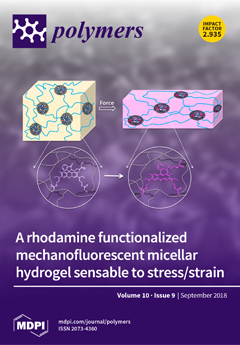In this paper, the high-density polyethylene/maleic anhydride grafted high-density polyethylene/polyamide 6 (HDPE/HDPE-
g-MA/PA6) ternary blends were prepared by blend melting. The binary dispersed phase (HDPE-
g-MA/PA6) is of a core-shell structure, which is confirmed by the SEM observation and theoretical calculation.
[...] Read more.
In this paper, the high-density polyethylene/maleic anhydride grafted high-density polyethylene/polyamide 6 (HDPE/HDPE-
g-MA/PA6) ternary blends were prepared by blend melting. The binary dispersed phase (HDPE-
g-MA/PA6) is of a core-shell structure, which is confirmed by the SEM observation and theoretical calculation. The crystallization behavior and mechanical properties of PA6, HDPE-
g-MA, HDPE, and their blends were investigated. The crystallization process, crystallization temperature, melting temperature, and crystallinity were studied by differential scanning calorimetry (DSC) testing. The results show that PA6 and HDPE-
g-MA interact with each other during crystallizing, and their crystallization behaviors are different when the composition is different. At the same time, the addition of core-shell particles (HDPE-
g-MA/PA6) can affect the crystallization behavior of the HDPE matrix. With the addition of the core-shell particles, the comprehensive mechanical properties of HDPE were enhanced, including tensile strength, elastic modulus, and the impact strength. Combined with previous studies, the toughening mechanism of core-shell structure is discussed in detail. The mechanism of the core-shell structure toughening is not only one, but the result of a variety of mechanisms together.
Full article






